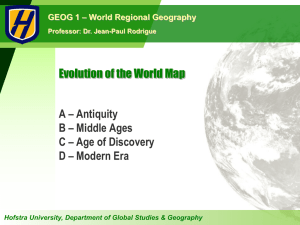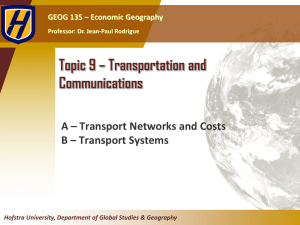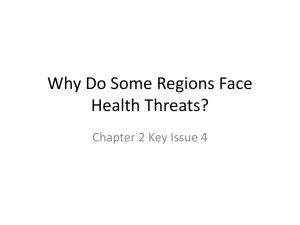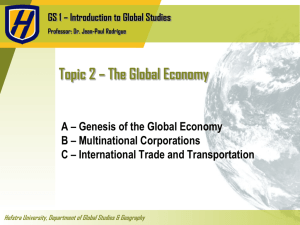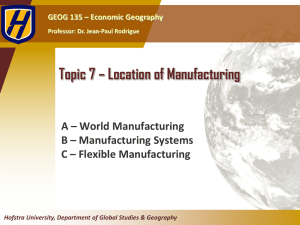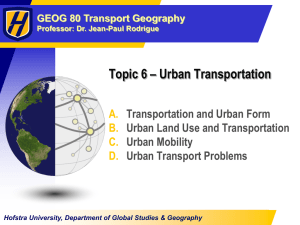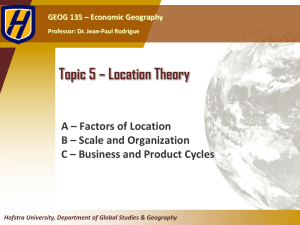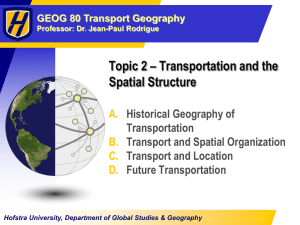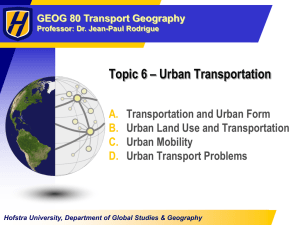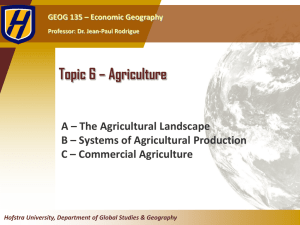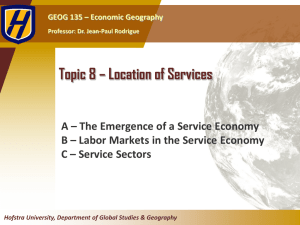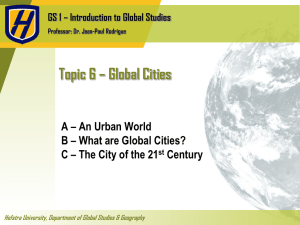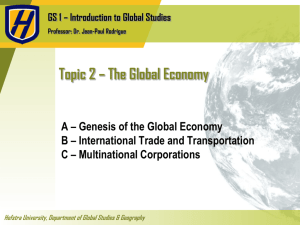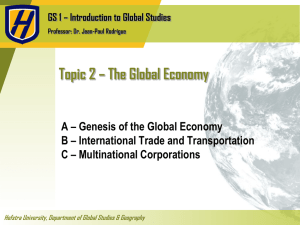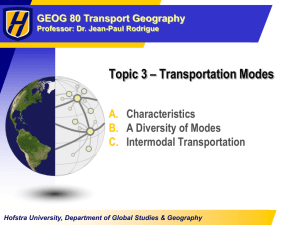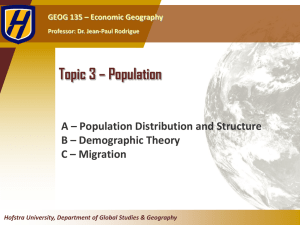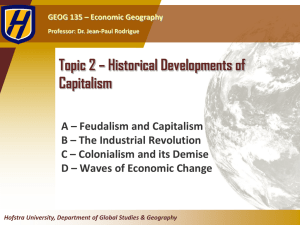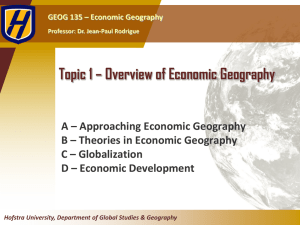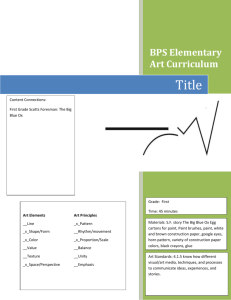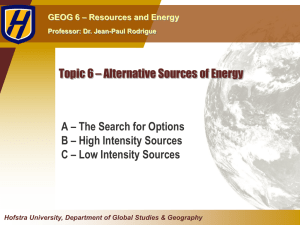Chapter 1 Transportation and Geography
advertisement
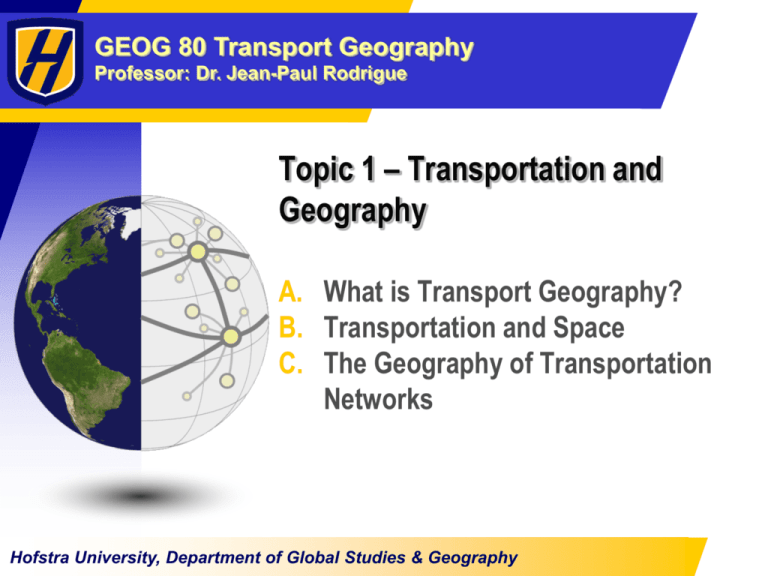
GEOG 80 Transport Geography Professor: Dr. Jean-Paul Rodrigue Topic 1 – Transportation and Geography A. What is Transport Geography? B. Transportation and Space C. The Geography of Transportation Networks Hofstra University, Department of Global Studies & Geography C – THE GEOGRAPHY OF TRANSPORTATION NETWORKS 1. Transport Networks 2. The Topology and Typology of Networks 3. Networks and Space © Dr. Jean-Paul Rodrigue 1. Transport Networks ■ Transport network • Framework of routes between locations: • A permanent track (e.g. roads, rail and canals). • A scheduled service (e.g. airline, public transit, train). • Various types of links between points along which movement can take place. • Creates accessibility. ■ Network structure • • • • Ranges from centripetal to centrifugal. Express inequalities between places. Express transport rates. Integration processes impacted on the structure and flows of transportation networks. © Dr. Jean-Paul Rodrigue Centrifugal and Centripetal Networks Centrifugal Centripetal © Dr. Jean-Paul Rodrigue Transport Hub Point-to-Point Hub-and-Spoke Hub © Dr. Jean-Paul Rodrigue Detour Level in a Hub-and-Spoke Network A 1 D B C © Dr. Jean-Paul Rodrigue Cost, Revenue and Level of Network Coverage A 4 5 3 7 Cost: 10 10 Revenue: 15 Benefit: 5 B Cost: 12 Revenue: 18 Benefit: 6 C Cost: 14 Revenue: 25 Benefit: 11 D Cost: 19 Revenue: 29 Benefit: 10 © Dr. Jean-Paul Rodrigue Impacts of Integration Processes on Networks and Flows Before Integration After Integration Flows Network International border © Dr. Jean-Paul Rodrigue 2. The Topology and Typology of Networks Linear ■ Topology • The arrangement and connectivity of a network. • Each network has a specific topology ■ Linear networks: Tree • Only one link between each node pairs. • Each node has a maximum of two links. ■ Tree networks: • Converging to one node from a hierarchy of other nodes. © Dr. Jean-Paul Rodrigue 2. The Topology and Typology of Networks Mesh ■ Mesh networks: • At least two nodes with two or more links between them. ■ Hub-and-spoke networks: Hub-and-Spoke • Peripheral nodes (spokes) are connected to a central node; the hub. © Dr. Jean-Paul Rodrigue Network Strategies to Service a Set of Locations A B C D E F © Dr. Jean-Paul Rodrigue Mode of Territorial Occupation by Transport Networks Clearly Defined Rail Overlap Vaguely Defined Air corridor Road Cellular coverage Without Definition Reserved space for transport infrastructure. Ownership clearly established. Road, canal and railway networks. Shared space. Not the object of any particular ownership, only rights of way. Air and maritime transportation networks. Space has no tangible meaning, except for as a distance. Little control and ownership. Common usage agreements. Radio, television and cellular networks. © Dr. Jean-Paul Rodrigue 3. Networks and Space ■ Shaping accessibility Transport Network Space Accessibility • The territory is a topological space having two or three dimensions, depending on the transport mode considered. • Flows and infrastructures are linear; having one dimension. • Accessibility is the transposition of a network over space. © Dr. Jean-Paul Rodrigue Absolute and Relative Distance in a Network 10 km 30 minutes © Dr. Jean-Paul Rodrigue Spatial Continuity by Transportation Mode Ubiquity Fractionalization Instantaneity Automobile High (road coverage the most extensive) None (1 passenger = 1 movement) High (available on demand) Transit Average (within metropolitan areas) Average (bus loads or train loads) Average to high (fixed high frequency schedules) Air transport Limited to airports (common) Average (plane loads from Average (fixed 50 to 500 passengers) schedules and connections) Maritime Limited to ports (rare) High (ship loads, reinforced by economies of scale) Rail Limited to rail terminals Average (train loads) (common) Average (fixed schedule) Pipeline Limited to network High (continuous flow) Low (continuous flow) Low (fixed schedules and connections) © Dr. Jean-Paul Rodrigue Networks and Spatial Continuity A B C © Dr. Jean-Paul Rodrigue Networks as Tools of Spatial Cohesion (Control) Period Emerging Network Outcome Pre-colonial Fluvial, coastal and road Empire building Colonial Era Maritime Trade, exploitation and political control 19th Century Canal and rail Nation building, commerce and political control 20th Century Highways and air National and transnational integration 21st Century Telecommunication Global supply chains © Dr. Jean-Paul Rodrigue
